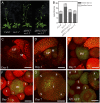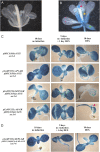Characterization of SOC1's central role in flowering by the identification of its upstream and downstream regulators
- PMID: 22791302
- PMCID: PMC3440217
- DOI: 10.1104/pp.112.202614
Characterization of SOC1's central role in flowering by the identification of its upstream and downstream regulators
Erratum in
- Plant Physiol. 2013 Aug;162(4):2151
Abstract
The transition from vegetative to reproductive development is one of the most important phase changes in the plant life cycle. This step is controlled by various environmental signals that are integrated at the molecular level by so-called floral integrators. One such floral integrator in Arabidopsis (Arabidopsis thaliana) is the MADS domain transcription factor SUPPRESSOR OF OVEREXPRESSION OF CONSTANS1 (SOC1). Despite extensive genetic studies, little is known about the transcriptional control of SOC1, and we are just starting to explore the network of genes under the direct control of SOC1 transcription factor complexes. Here, we show that several MADS domain proteins, including SOC1 heterodimers, are able to bind SOC1 regulatory sequences. Genome-wide target gene analysis by ChIP-seq confirmed the binding of SOC1 to its own locus and shows that it also binds to a plethora of flowering-time regulatory and floral homeotic genes. In turn, the encoded floral homeotic MADS domain proteins appear to bind SOC1 regulatory sequences. Subsequent in planta analyses revealed SOC1 repression by several floral homeotic MADS domain proteins, and we show that, mechanistically, this depends on the presence of the SOC1 protein. Together, our data show that SOC1 constitutes a major hub in the regulatory networks underlying floral timing and flower development and that these networks are composed of many positive and negative autoregulatory and feedback loops. The latter seems to be crucial for the generation of a robust flower-inducing signal, followed shortly after by repression of the SOC1 floral integrator.
Figures






Similar articles
-
Genome-wide identification of SOC1 and SVP targets during the floral transition in Arabidopsis.Plant J. 2012 May;70(4):549-61. doi: 10.1111/j.1365-313X.2012.04919.x. Epub 2012 Mar 5. Plant J. 2012. PMID: 22268548
-
Crosstalk between cold response and flowering in Arabidopsis is mediated through the flowering-time gene SOC1 and its upstream negative regulator FLC.Plant Cell. 2009 Oct;21(10):3185-97. doi: 10.1105/tpc.108.063883. Epub 2009 Oct 13. Plant Cell. 2009. PMID: 19825833 Free PMC article.
-
Direct interaction of AGL24 and SOC1 integrates flowering signals in Arabidopsis.Development. 2008 Apr;135(8):1481-91. doi: 10.1242/dev.020255. Epub 2008 Mar 13. Development. 2008. PMID: 18339670
-
Regulation and function of SOC1, a flowering pathway integrator.J Exp Bot. 2010 May;61(9):2247-54. doi: 10.1093/jxb/erq098. Epub 2010 Apr 22. J Exp Bot. 2010. PMID: 20413527 Review.
-
Just say no: floral repressors help Arabidopsis bide the time.Curr Opin Plant Biol. 2009 Oct;12(5):580-6. doi: 10.1016/j.pbi.2009.07.006. Epub 2009 Aug 18. Curr Opin Plant Biol. 2009. PMID: 19695946 Review.
Cited by
-
The flowering transition pathways converge into a complex gene regulatory network that underlies the phase changes of the shoot apical meristem in Arabidopsis thaliana.Front Plant Sci. 2022 Aug 9;13:852047. doi: 10.3389/fpls.2022.852047. eCollection 2022. Front Plant Sci. 2022. PMID: 36017258 Free PMC article.
-
Computational identification and analysis of MADS box genes in Camellia sinensis.Bioinformation. 2015 Mar 31;11(3):115-21. doi: 10.6026/97320630011115. eCollection 2015. Bioinformation. 2015. PMID: 25914445 Free PMC article.
-
Exploring silique number in Brassica napus L.: Genetic and molecular advances for improving yield.Plant Biotechnol J. 2024 Jul;22(7):1897-1912. doi: 10.1111/pbi.14309. Epub 2024 Feb 22. Plant Biotechnol J. 2024. PMID: 38386569 Free PMC article. Review.
-
Floral pathway integrator gene expression mediates gradual transmission of environmental and endogenous cues to flowering time.PeerJ. 2017 Apr 19;5:e3197. doi: 10.7717/peerj.3197. eCollection 2017. PeerJ. 2017. PMID: 28439467 Free PMC article.
-
Photoperiod-responsive changes in chromatin accessibility in phloem companion and epidermis cells of Arabidopsis leaves.Plant Cell. 2021 May 5;33(3):475-491. doi: 10.1093/plcell/koaa043. Plant Cell. 2021. PMID: 33955490 Free PMC article.
References
-
- Adamczyk BJ, Lehti-Shiu MD, Fernandez DE. (2007) The MADS domain factors AGL15 and AGL18 act redundantly as repressors of the floral transition in Arabidopsis. Plant J 50: 1007–1019 - PubMed
-
- Alon U. (2007) Network motifs: theory and experimental approaches. Nat Rev Genet 8: 450–461 - PubMed
-
- Alonso JM, Stepanova AN, Leisse TJ, Kim CJ, Chen HM, Shinn P, Stevenson DK, Zimmerman J, Barajas P, Cheuk R, et al. (2003) Genome-wide insertional mutagenesis of Arabidopsis thaliana. Science 301: 653–657 - PubMed
-
- Benlloch R, Kim MC, Sayou C, Thevenon E, Parcy F, Nilsson O. (2011) Integrating long-day flowering signals: a LEAFY binding site is essential for proper photoperiodic activation of APETALA1. Plant J 67: 1094–1102 - PubMed
Publication types
MeSH terms
Substances
LinkOut - more resources
Full Text Sources
Molecular Biology Databases
Research Materials

